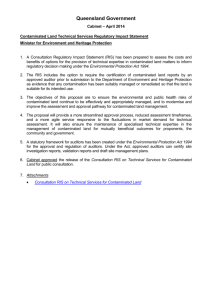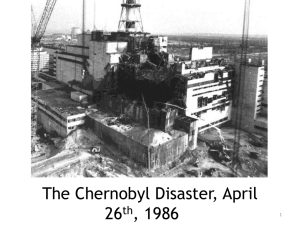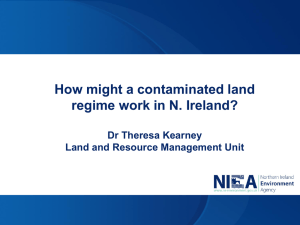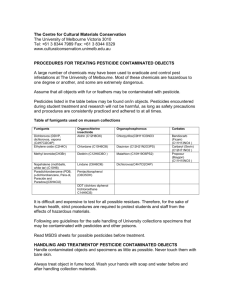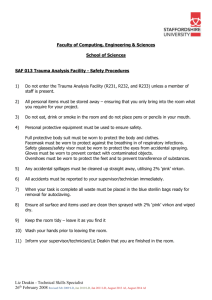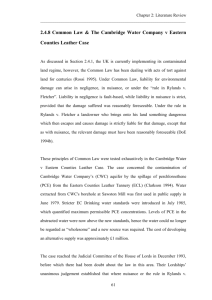Soil Focus Group Meeting - The Scottish Government
advertisement
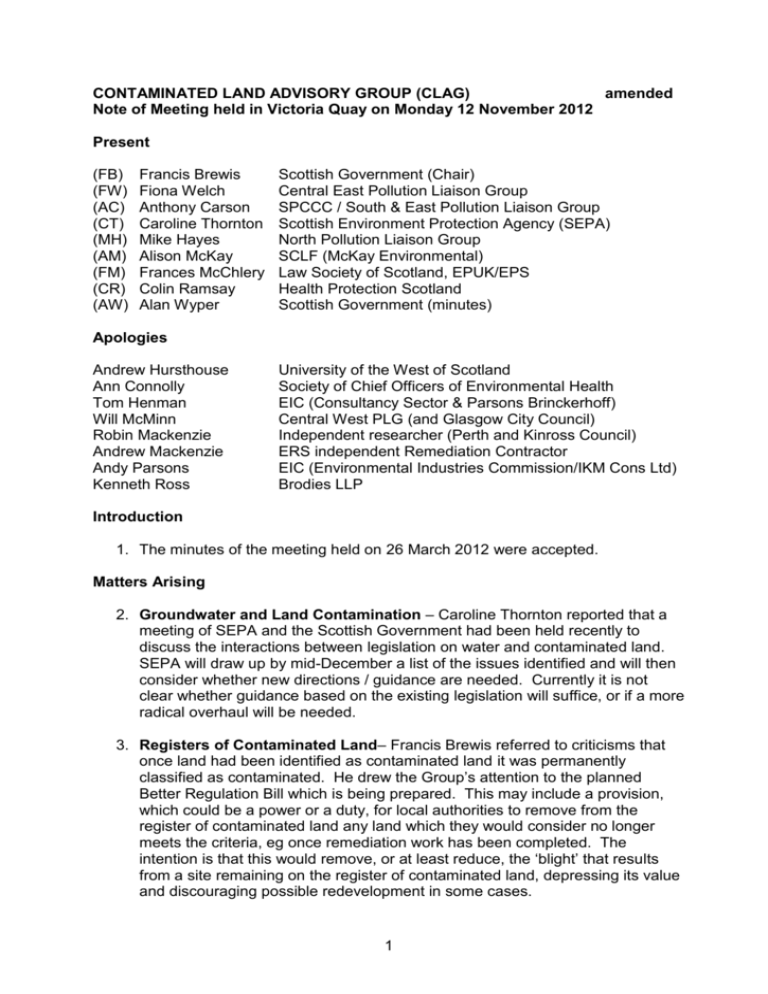
CONTAMINATED LAND ADVISORY GROUP (CLAG) amended Note of Meeting held in Victoria Quay on Monday 12 November 2012 Present (FB) (FW) (AC) (CT) (MH) (AM) (FM) (CR) (AW) Francis Brewis Fiona Welch Anthony Carson Caroline Thornton Mike Hayes Alison McKay Frances McChlery Colin Ramsay Alan Wyper Scottish Government (Chair) Central East Pollution Liaison Group SPCCC / South & East Pollution Liaison Group Scottish Environment Protection Agency (SEPA) North Pollution Liaison Group SCLF (McKay Environmental) Law Society of Scotland, EPUK/EPS Health Protection Scotland Scottish Government (minutes) Apologies Andrew Hursthouse Ann Connolly Tom Henman Will McMinn Robin Mackenzie Andrew Mackenzie Andy Parsons Kenneth Ross University of the West of Scotland Society of Chief Officers of Environmental Health EIC (Consultancy Sector & Parsons Brinckerhoff) Central West PLG (and Glasgow City Council) Independent researcher (Perth and Kinross Council) ERS independent Remediation Contractor EIC (Environmental Industries Commission/IKM Cons Ltd) Brodies LLP Introduction 1. The minutes of the meeting held on 26 March 2012 were accepted. Matters Arising 2. Groundwater and Land Contamination – Caroline Thornton reported that a meeting of SEPA and the Scottish Government had been held recently to discuss the interactions between legislation on water and contaminated land. SEPA will draw up by mid-December a list of the issues identified and will then consider whether new directions / guidance are needed. Currently it is not clear whether guidance based on the existing legislation will suffice, or if a more radical overhaul will be needed. 3. Registers of Contaminated Land– Francis Brewis referred to criticisms that once land had been identified as contaminated land it was permanently classified as contaminated. He drew the Group’s attention to the planned Better Regulation Bill which is being prepared. This may include a provision, which could be a power or a duty, for local authorities to remove from the register of contaminated land any land which they would consider no longer meets the criteria, eg once remediation work has been completed. The intention is that this would remove, or at least reduce, the ‘blight’ that results from a site remaining on the register of contaminated land, depressing its value and discouraging possible redevelopment in some cases. 1 4. Frances McChlery thought the proposal sounded positive and that it would be welcomed by the Law Society of Scotland, but was surprised that it was being brought forward through the Better Regulation Bill, as she did not recall it being mentioned in the consultation. [The question had arisen in connection with radioactivity found at Dalgety Bay.] Anthony Carson and Michael Hayes expressed reservations, as they felt the existing arrangements already allowed for the clear recording of remediated land and that any move to take sites off the register would undermine transparency. Members valued the function of the Public Register in recording the remediation that had been carried out on the land identified; the remediation statement should record the local authority decision making and should remove the ‘contamination status’ of a piece of land that was no longer contaminated. FB said that the Scottish Government was not intending that anyone should hide the fact that a site had once been identified (such facts would be releasable under Environmental Information legislation), but to help show, where appropriate, that sites were no longer ‘contaminated’. There was general agreement that it was desirable for remediated land to be seen as such, but simply allowing local authorities to remove sites from the contaminated land register was not regarded as acceptable. 5. There was also a suggestion that this could provide an opportunity for the register requirements to be wider i.e. to record actual activity under Part IIA including detailed inspections and the findings of those inspections (contaminated land or not contaminated land). This would provide a more transparent record of land that had undergone detailed inspected, and where a conclusion had been reached that it does NOT meet the statutory definition LAs should be empowered to say it should no longer be called “Contaminated Land”. FB asked FM if she could provide advice based on Law Society (or panel) earlier consideration of the question. Commissioned Research: Contaminated Land and Human Health 6. The commissioned research report, Review of methods to assess risk to human health from contaminated land, produced by Alison Searl of the Institute of Occupational Medicine was put to the Group for discussion. The draft report had been through two rounds of comments by the steering group, though it has not been endorsed. 7. The general opinion of the Group on the report was positive. Dr Colin Ramsay thought that the remit to take a comparative look at different methods and regimes for dealing with contaminated land had been fulfilled well. The report was particularly helpful from a medical point of view and provides a very good explanation of the Significant Possibility of Significant Harm (SPOSH) concept. 8. There was some doubt expressed by MH and AC about the proposal on initial assessment, specifically whether checking a limited data set against Generic Assessment Criteria (GAC) would be compatible with the British Standard. There was also some concern about the degree of fit between the report and the existing guidance. Alison McKay felt the report devoted disproportionate 2 attention to setting out the Contaminated Land Exposure Assessment process. However, FM thought that setting out the process in this kind of detail could prove to be useful in the event of future legal cases. 9. The Group was positive about the Benchmark Dose (BMD) / Margin of Exposure (MoE) approach presented in the report. It was noted that it would need further studies designed to give ‘reference doses’ representing unacceptable intake for specific contaminants. It was thought that this should be taken forward by the Scottish Government, as local authorities would not have the toxicological expertise or the resources to develop these kinds of standards. It would also be unwise to potentially have different standards applied in different parts of the country. It was agreed that the Scottish Government should look into the possibility of funding a pilot research project to develop a method for the generation of standard reference doses that would represent unacceptable intake and to trial the method on (say) 6 substances which are commonly encountered. A suggestion was made to base the study on a particular substance, or group of substances, such as those found at the sites of former gasworks, with a view to expanding this to develop a full programme of Scottish standard reference doses. It was suggested that the report author, Alison Searl, should be invited to prepare a scope of works for a possible research project on a possible method of generating standard reference doses. Action Point 1 – FB to approach Alison Searl about scoping a pilot study and to look into seeking Scottish Government funding for it. 10. FB asked the Group whether they would be happy for the Scottish Government to publish the report on its website, as it normally does with research it commissions. There was some concern about publishing Section 5 of the report on Draft Guidance, as the Group have not fully considered it yet and may not agree with all of it. However, FB stressed that publishing the document does not necessarily constitute endorsement and that convention would strongly support publication. FB asked if there were any specific points of fact or clarification, with a view to amendments to the text, which members could email to him in the next week, to be passed on to Alison Searl. Action Point 2 – Comments and amendments on the report to be sent to FB. [None received.] Any Other Business 11. FM raised the possibility of EPS organising an event in the New Year on contaminated land issues, and this was welcomed by the Group. Date of Next Meeting 12. The next meeting should be held in January 2013 to discuss the way forward on the criteria for identifying land, both in relation to human health, following the IOM Report and the water environment, building on SEPA’s consideration of the issue. 3 Alan Wyper and Francis Brewis December 2012 (revised March 2013) 4
